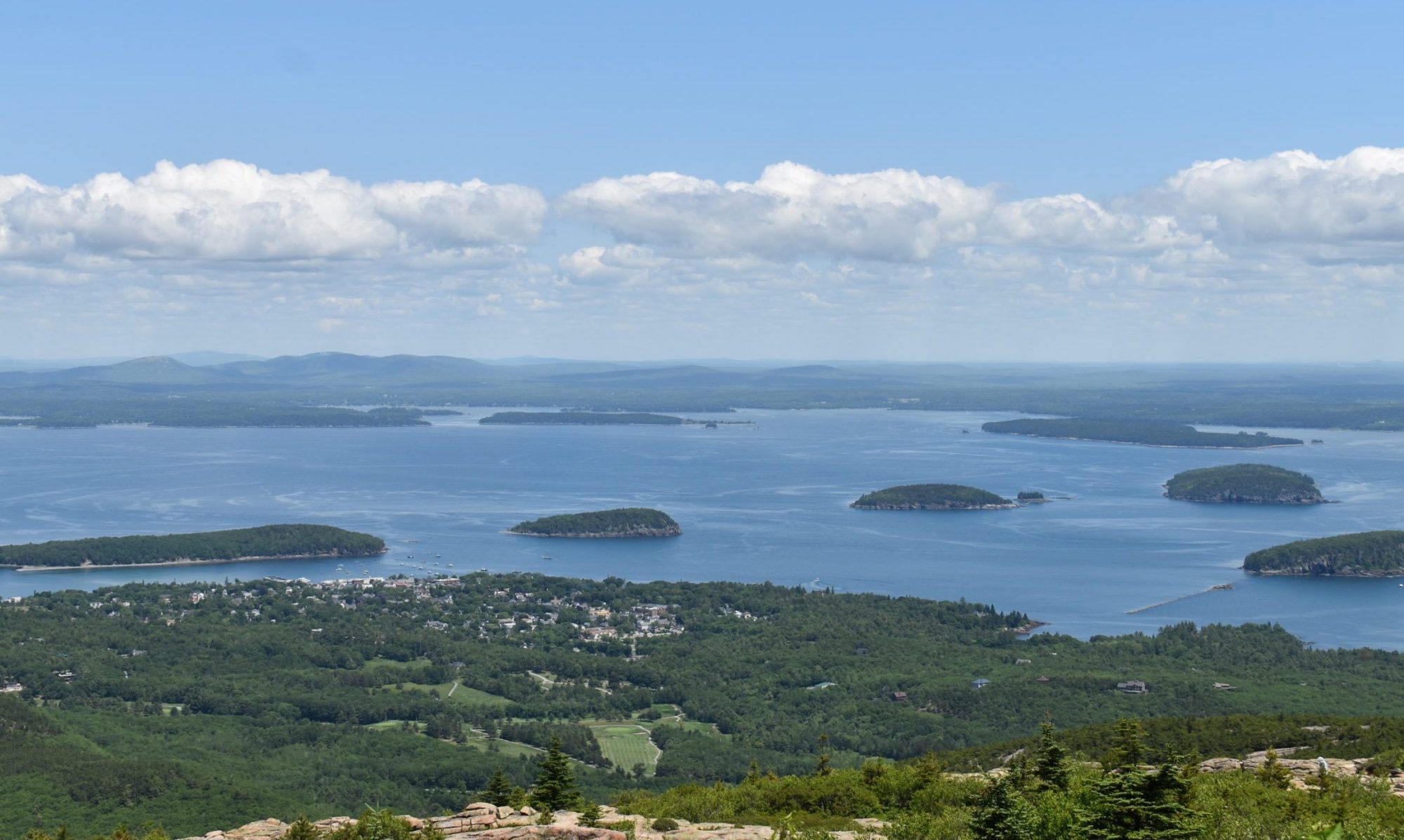Hiking Information
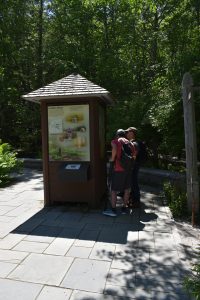
Acadia National Park offers over 158 miles of hiking trails to explore, catering to various preferences. Moreover, the trails range from those with ocean views, mountain peaks, and forests, making them suitable for hikers of all abilities. Additionally, many of the park's hiking trails are short. This allows hikers to combine them and create longer, more diverse hiking loops. Furthermore, while most hiking activities in Acadia occur during the spring, summer, and fall, winter hiking is also common.
Among Acadia's well-known trails are the Precipice and Beehive Trails. These trails feature metal rungs and ladders, providing an adventurous experience. However, they often get crowded, potentially diminishing the hiking experience. As an alternative for those seeking an equally adventurous but less crowded option with rungs and ladders, the Ladder Trail or the Beech Cliff Loop are recommended.
The park is also famous for its scenic trails like Ocean Path and the Ship Harbor Nature Trail. These trails offer easy hikes for those who prefer a leisurely stroll to enjoy nature. Additionally, Ocean Path, in particular, passes by several popular attractions within the park. These include Sand Beach, Thunder Hole, and Otter Cliffs. This makes it an excellent choice for visitors who want to experience multiple popular attractions of Acadia National Park during a single hike.
Try Our Trail Map & Trail Finder
Now that you know all about hiking in Acadia National Park, try our Trail Map and Trail Finder features to find the perfect trail for you.
Hiking Safety
Summer Hiking Safety
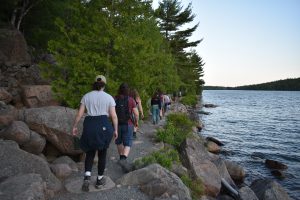 During the summer, hiking in Acadia National Park becomes one of the most popular activities, resulting in busy, crowded, and potentially dangerous trails. Consequently, to ensure safety, adequately preparing becomes crucial. This involves considering three important factors: Firstly, monitoring weather conditions. Secondly, maintaining locational awareness. And thirdly, packing essential items in your backpack.
During the summer, hiking in Acadia National Park becomes one of the most popular activities, resulting in busy, crowded, and potentially dangerous trails. Consequently, to ensure safety, adequately preparing becomes crucial. This involves considering three important factors: Firstly, monitoring weather conditions. Secondly, maintaining locational awareness. And thirdly, packing essential items in your backpack.
-
- Weather Conditions - The extreme weather changes constitute one of the biggest hiking hazards during summer in Acadia. The weather can shift suddenly from sunny to stormy, posing risks to hikers. Additionally, wet and slippery trails are a common weather-related issue in Acadia, especially after rain or heavy fog, turning mountain trails into potential streams and increasing the likelihood of slips and falls, particularly for those with inadequate footwear. To prevent encountering these dangerous conditions, hikers should consistently check the weather forecast. Given the limited service within the park, it is advisable to check the forecast before arriving and always be prepared for the worst-case scenario. It's essential to pack a rain jacket in your backpack and wear appropriate footwear to mitigate potential risks.
- Locational Awareness - Hikers in Acadia often face the issue of losing their locational awareness in the woods. The park's unusual setup means that many hiking trails are short, encouraging hikers to link them together to create more enjoyable loops. However, without a map or guide, some people may inadvertently take the wrong turn and end up far from their starting point. To address this problem, it is crucial to always carry a hiking map or guidebook. These maps can be obtained at information centers, online, or at local stores. Additionally, hikers should mentally note the points where their intended trail intersects with another trail or the trails involved in their planned loop. While many intersections have clear trail signage and are easy to follow, occasional unmarked break-off trails or confusing spots may exist. Sticking to well-marked paths should ensure a smoother hiking experience. Another consideration is the peregrine falcon trail closures during the summer, but all these closed trails are appropriately marked with signs.
- Packing Essentials - The last issue we will cover here is the essential items to bring on your hike. Many people underestimate their hiking needs, assuming it will be a short trip and thus neglecting to pack necessities such as water and a first aid kit. Here is a list of items to consider bringing with you on a summer hike in Acadia:
- Appropriate footwear such as hiking boots with good grip and ankle support.
- A map or guidebook and compass or GPS to help support locational awareness.
- Water and snacks to keep your body in peak performance.
- Extra clothing layers such as a rain jacket, fleece, etc.
- Safety items such as a head lamp, a whistle, and a multipurpose tool.
- First aid kit with band aids, antibacterial ointment, hand sanitizer, etc.
- Sun screen especially on those foggy days that hide the sun, but end up scorching your skin.
- A comfortable backpack with appropriate support.
Winter Hiking Safety
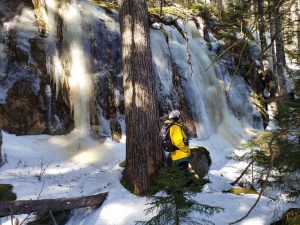
Winter hiking in Acadia is not often a busy time; however, hikers must take many other safety precautions into account. Below, we provide a list of general winter hiking tips, but it is essential to conduct further research beyond this page.
-
- Check the latest local forecast for weather updates.
- Check the NPS Current Conditions for emergency alerts and closure updates.
- Consider a less challenging hike such as Ship Harbor, Ocean Path, or a carriage road. More difficult routes can be extremely dangerous in winter conditions.
- Wear proper footwear such as crampons, cleats, ice grippers, or other traction footwear, as trails are often covered in snow and ice. Trekking poles are also highly encouraged.
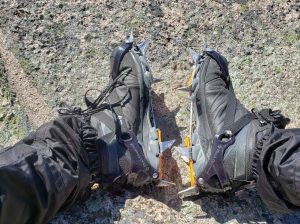
- Hike with a friend or tell someone your itinerary.
- Start your hike earlier in the day to avoid getting stuck in the dark as daylight hours are short in the winter.
- Be prepared to turn around and head back.
- Depending on snow levels, trail markers may be out of view, so make sure to bring a map or guidebook and compass or GPS.
- Dress in layers and bring more than you think you will need. Always make sure to bring a waterproof layer and consider hand/toe warmers.
- Bring plenty of water and snacks.
- Stay alert for signs of frostbite or hypothermia.
More Safety Information
Learn about other safety precautions on our Safety page and through the NPS Safety page.
Thinking About Going for a Swim?
Discover information about swimming in Acadia and water safety using the links below.
Leave No Trace
Leave No Trace extends the National Park Service mission to all visitors and challenges them to "…conserve the scenery and the natural and historic objects and the wild life therein and to provide for the enjoyment of the same in such manner and by such means as will leave them unimpaired for the enjoyment of future generations."
Here are the Leave No Trace Seven Principles from the Friends of Acadia:
-
- Plan Ahead and Prepare. Know the regulations and special concerns for the area you’ll visit.
- Travel and Camp on Durable Surfaces.
- Dispose of Waste Properly.
- Leave What You Find.
- Minimize Campfire Impacts.
- Respect Wildlife.
- Be Considerate of Other Visitors.
How to Leave No Trace

Learn more about Leave No Trace on the NPS website and see how you can help preserve the park for future generations.
